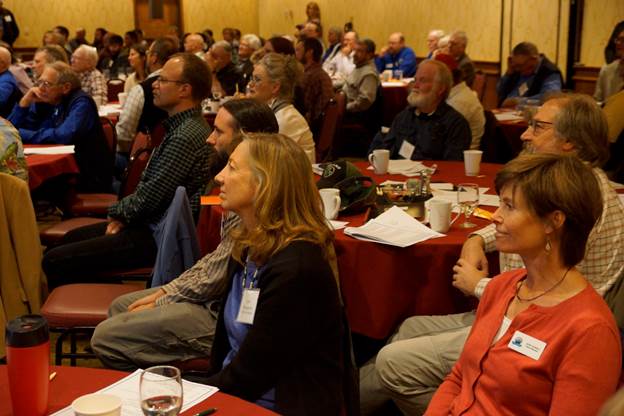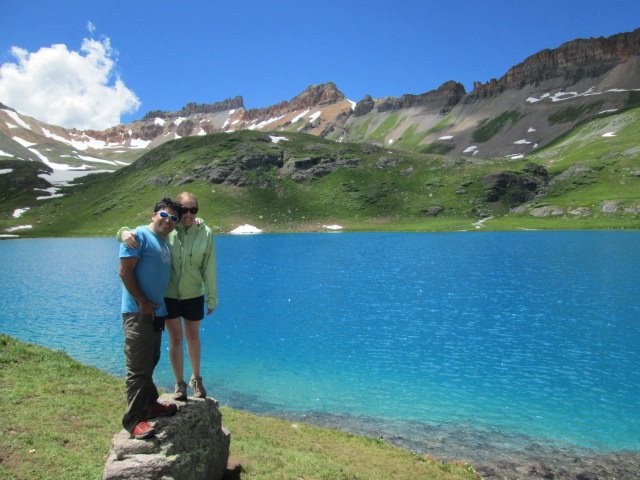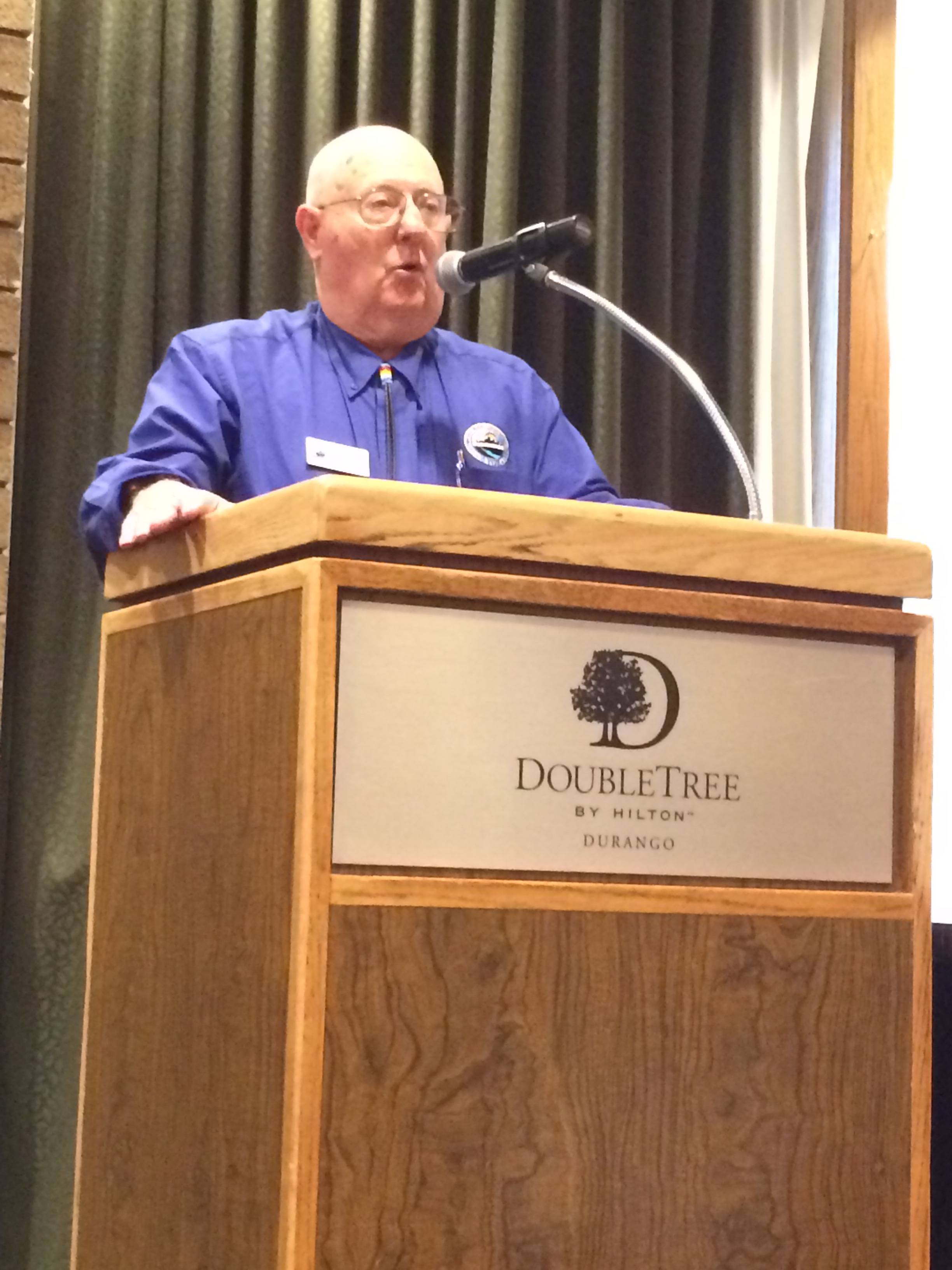By Laura Spann

A full crowd of nearly 200 people attended the Southwestern Water Conservation District’s Annual Water Seminar this year, celebrating the district’s 75th anniversary.
A record 190 people attended the Southwestern Water Conservation District’s (SWCD) Annual Water Seminar on April 1 in Durango. Marking the 75th anniversary of the district, the seminar focused on lessons in water management learned since 1941. This was no small task, but Board President John Porter took it upon himself to read half a century of board minutes to give the audience that historical perspective. Mr. Porter wrote an op-ed that appeared in the Durango Herald and papers across southwestern Colorado, explaining how those lessons learned inform the district’s current activities. Read his piece below:
John Porter, president of the Southwestern Water Conservation District, addressed the group at the district’s annual water summit, sharing lessons learned over the past 75 years, and that will carry forward through the next 75 years.
Created in 1941 by the Colorado General Assembly, the Southwestern Water Conservation District encompasses Archuleta, Dolores, La Plata, Montezuma, San Juan, San Miguel and parts of Hinsdale, Mineral and Montrose counties. As board president, I would like to share some lessons learned in the past 75 years, ones we’ll carry through the next 75.
Lesson No. 1: Adaptability is a necessity
Times have changed since 1941. Colorado statute charges the district with “protecting, conserving, using and developing the water resources of the southwestern basin for the welfare of the district, and safeguarding for Colorado all waters of the basin to which the state is entitled.” Following this mandate, the district worked tirelessly for decades to ensure water supplies would meet growing demand by filing for storage project water rights in almost every major river basin. SWCD lobbied for federal dollars to be spent on project construction in our area. The philosophy was, and continues to be, to plant the seed and help it grow.
This work resulted in the establishment of the Florida Water Conservancy District and Lemon Reservoir; the Pine River Project extension; the Dolores Water Conservancy District and McPhee Reservoir; the Animas-La Plata Water Conservancy District; Ridges Basin Reservoir; Long Hollow Reservoir; the San Juan Water Conservancy District; and the proposed Dry Gulch Reservoir.
As population pressure threatens to dry up agriculture, and regulations and constituent values have expanded to include environmental protections and recreational use, the district’s mission has adapted necessarily. When the A-LP Project debate was underway, for example, SWCD was integral in the formation of the San Juan Recovery Program, established to recover endangered fish species populations in the San Juan River in New Mexico downstream of the proposed reservoir. SWCD currently funds a variety of essential work, including stream flow data collection and mercury sampling in local reservoirs. To address mounting concerns regarding future compact curtailment and drought, SWCD supports water supply augmentation through winter cloud seeding and exploring creative solutions like “water banking.”
Lesson No. 2: Be at the table
Participation at the local, state and federal levels is essential to protecting our resources. That’s why the district is a member of Colorado Water Congress, a state entity focused on water policy.
The district takes positions and engages in debate on water-related bills during the state legislative season. We keep a close eye on federal water management policies, often submitting public comments and working with federal and state partners to ensure continued state control of water rights. The district is supportive of the Colorado Water Conservation Board’s instream flow program to establish minimum stream flows for the environment, and is working to improve the program’s ability to adapt to rural community needs for future development. As for the broader Colorado River system, SWCD participates in dialogue among Upper Basin states through the Upper Colorado River Commission.
At the local level, the district has represented water development interests in the collaborative River Protection Workgroup, which resulted in the Hermosa Creek Watershed Act. SWCD worked with other Roundtable members to ensure our corner of the state was heard in the Colorado Water Plan.
Lesson No. 3: Reinvest local tax dollars locally
It’s a not-so-well-kept secret that SWCD’s grant program supports water work across the district: domestic supply and irrigation infrastructure improvements, recreational development, habitat rehabilitation, collaborative community processes and water quality studies. Here are a few recent examples:
Archuleta, Mineral and Hinsdale counties: Rio Blanco habitat restoration by the San Juan Conservation District, watershed health via the San Juan Mixed Conifer GroupLa Plata County: initial studies for Long Hollow Reservoir, the La Plata West Water Authority’s rural domestic water system
San Juan County: Center for Snow & Avalanche Studies dust-on-snow research, mining reclamation through the Animas River Stakeholders Group
Montezuma and Dolores counties: the Dolores River Dialogue (a collaboration focused on issues below McPhee Dam), irrigation efficiency improvements by the High Desert Conservation District
San Miguel and Montrose counties: the San Miguel Watershed Coalition’s watershed studies and irrigation diversion improvements to allow fish and boater passage, domestic system upgrades for the town of Norwood
Lesson No. 4: Educate the next generation of leaders
For more than 20 years, the district has spearheaded regional water education by sponsoring an Annual Children’s Water Festival for students across the basin and administering the Water Information Program with contributions from participating entities. SWCD played an instrumental role in creating the statewide Colorado Foundation for Water Education, and continues to sponsor the organization.
As generations of water leaders step back, new stewards must step forward to ensure that the Southwest Colorado we know and love continues.

Bill McDonald reviews the evolution of water management.
The full and informative day included talks from Justice Greg Hobbs, now a mediator with the Colorado Supreme Court; and Bill McDonald, former Colorado Water Conservation Board Director and U.S. Bureau of Reclamation Deputy Commissioner, who reviewed the evolution of water management to the era of conservation districts. Southern Ute Indian Tribal Chairman Frost and Ute Mountain Ute Tribal legal counsel Leland Begay spoke on generations of tribal water resources stewardship.
A diverse selection of water-related entities —from watershed health advocates to ditch companies, from Pagosa Springs to Norwood—presented on their organizations and projects funded by the SWCD. At lunch, the crowd played “Are you Smarter than a Fifth Grader?” with the “Water Wizard” Dave Grey, a trivia game based on questions asked to fifth graders at the Children’s Water Festival hosted by SWCD each year. Finally, the seminar would have been incomplete without recognition of water leader Fred Kroeger, who passed away in December 2015.
Wish you had been there? Durango TV covered the event. Also, presentations are available on SWCD’s website. Save the date for next year’s seminar: Friday, April 7, 2017!
 Laura Spann works for the Southwestern Water Conservation District based in Durango. She grew up on her family’s cattle ranch in Gunnison, Colorado. Laura received a B.A. in Government and International Relations from Claremont McKenna College. After working in Washington, D.C. for two years and Peru for another four years, Laura is happy to be back in Colorado learning about the pressing resource issues her home state faces.
Laura Spann works for the Southwestern Water Conservation District based in Durango. She grew up on her family’s cattle ranch in Gunnison, Colorado. Laura received a B.A. in Government and International Relations from Claremont McKenna College. After working in Washington, D.C. for two years and Peru for another four years, Laura is happy to be back in Colorado learning about the pressing resource issues her home state faces.


 Print
Print
Reblogged this on Coyote Gulch.